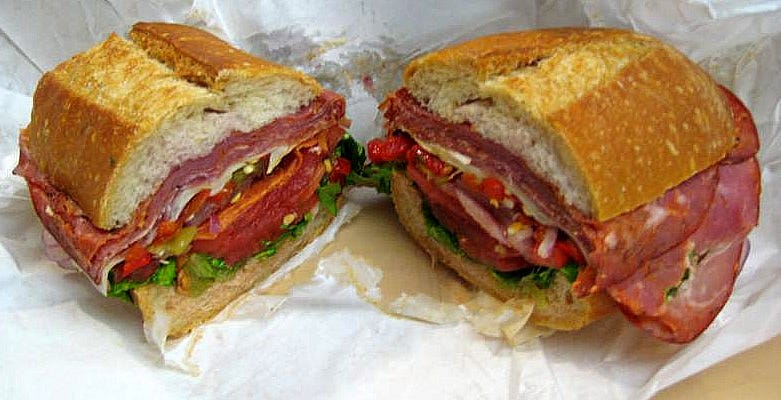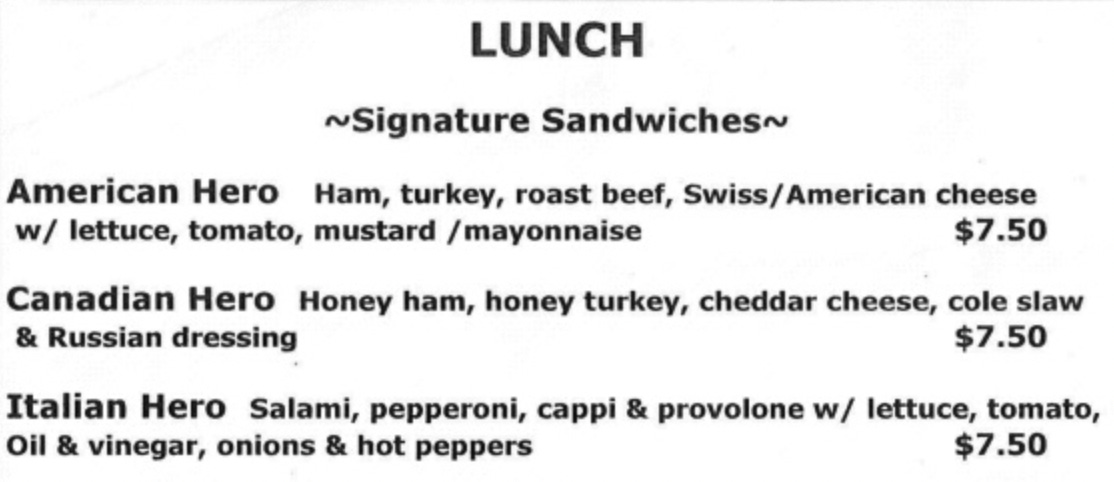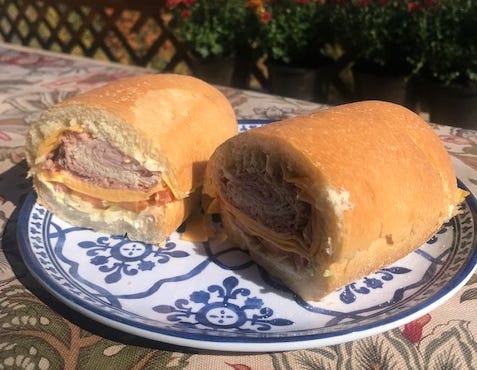Notable Sandwiches #1: The Real American Hero
Thirteen ways of looking at a submarine sandwich
I’ve been obsessed with Wikipedia’s “List of Notable Sandwiches” for years.
First of all, I love the idea of notable sandwiches — for so much in human existence is ephemeral, for knowledge is so precious and so easy to lose, and what is notable must be noted, sandwiches and all.
Secondly, there are so many goddamn sandwiches on that list. Hundreds of sandwiches! They are from everywhere, they are full of everything, they are unified only in their sandwichness, and the fact that someone, somewhere sat down and wrote about them on the Internet, and someone else included them on this strange and magnificent grid.
Just look at the landing page copy. So sparse. So terse. Yet it contains so much.
“This is a list of notable sandwiches. A sandwich is a dish consisting of two or more pieces of bread with one or more fillings between them, or one slice in the case of an open sandwich. Sandwiches are a common type of lunch food often eaten as part of a packed lunch. There are many types of sandwiches, made from a diverse variety of ingredients. The sandwich is the namesake of John Montagu, 4th Earl of Sandwich, a British sitatesman.
Major types of sandwiches include:
Two slices of bread with other ingredients between
Two halves of a baguette or roll with other ingredients between
Club sandwich
Hero, hoagie, or submarine sandwich
Open-faced sandwich
Pocket sandwich
Sandwich cookies and ice cream sandwiches are generally not considered sandwiches in the sense of a bread-containing food item, but are named by analogy.”
I love the thoughtfulness of including analogical sandwiches. And I love that there are three separate footnotes for “A sandwich is a dish consisting of two or more pieces of bread with one or more fillings between them,” which are as follows:
— Abelson, Jenn. "Arguments spread thick". The Boston Globe, 10 November 2006. Retrieved 27 May 2009.
— "sandwich". Merriam-Webster. Merriam-Webster, Incorporated.
— Foundations of Restaurant Management & Culinary Arts Level Two. Pearson. 2011. p. 53.
Dedication and specificity are two beautiful things to watch in action. And I hope in Notable Sandwiches to honor the dedication and specificity of the sandwich listmakers. I’d thought to make this into a blog in the era of blogs: I wanted to cook each one. Then I discovered a project called The Sandwich Tribunal, whose members have been doing just that, since 2014. So now I am content merely to discuss sandwiches in the age of newsletters.
Much ado has been made about what a sandwich consists of (is a hot dog a sandwich?!?!?!) and I will not be weighing in on such delicate epistemological concerns. The parameters of this project are contained within the Notable Sandwiches page; if something is a notable sandwich it is a sandwich, and we will discuss each one, and we will be doing it in alphabetical order. Starting with American Sub.
Initially, I was worried about starting with this sandwich, as, of all the sandwiches in the world, I don’t have a particular emotional connection to this one — to me, it’s wrapped up in the strange metallic chemical smell of Subway sandwich shops, and the best I’ve tasted don’t announce themselves as submarine sandwiches, and are sold exclusively in the Bronx, in Italian shops where you can ask for extra vinegar, and they hurry it out on a dense sesame-seed roll in the rough shape of an underwater military vessel and it’s bejeweled with red peppers and they just call it a sandwich. Nonetheless, it’s an icon, a steadfast sandwich, and one with an unbelievable lexicographical variety attached. The Wikipedia page cites a 1967 article in the journal American Speech in which the two august authors, Edwin Eames and Howard Robboy, set about finding all the variations on the name of the sandwich in the United States. (“Before beginning the library research and continuing throughout the entire study, we used informants from various cities to establish an initial list of terms for this sandwich.”) There’s also a table of “Terms Used for Submarine Sandwich in One Hundred American Cities Listed Alphabetically,” unearthed mainly by checking telephone directories and classifieds.
The thirteen names — thirteen ways of looking at a sandwich, to crib Wallace Stevens — are these: submarine, hoagie, poor boy, grinder, torpedo, Italian sandwich, hero, rocket, zeppelin, garibaldi (Madison, Wisconsin), bomber, musalatta (New Orleans), Cuban Sandwich, and none (the spectral and nameless sandwich). A strange mix of martial imagery, American-Italian dialect, and “hoagie” (which, Britannica tells me, comes from the fact that Philly-area Italian immigrants worked at the Hog Island shipyard in the ‘40s, and it was originally named the “hoggy” sandwich, and then, well, vowels slip.)
Incidentally, one of the authors of the article, Howard Robboy, is perhaps the world’s premier hoagie historian: a Philly native since his Jewish family arrived from Russia in the ‘20s, he has an archive known among historians as the Hoagie Papers, which is, once again, a model of dedication and specificity.
But all this is prelude and noise, such as that produced by a bomber or a zeppelin, signifying little. I will tell you one more little story:
During a very dark period just before the launch of this newsletter, in which I found myself so isolated I felt myself going a bit wild and restive and feral, darkness eating at the edge of the soul, and I wasn’t eating much at all, my editor, David Swanson, came to visit, knowing that, in the grips of agoraphobia, I couldn’t leave my house to come see him. We’ve known each other for years, since I started writing at the Village Voice as a sprightly tyke of a journalist with loud and sesquipedalian opinions, and he has always been generous with me, to a fault. We sat on the park bench near my house and I smoked and we talked: about the effects of these dark years on our minds, about the project we were embarking on together, about my fears — my page fright, stage fright, and the possibility and the joy mixed up there somewhere just under the fear. It was a kind visit and a kind talk, and we got around to sandwiches. And he asked if I had thoughts on the American hero. I had little to say: mostly I said I imagined crunching into a warship full of sailors, and how funny it was that that term was so widespread. (This is writer talk for “I got nothin’.”) And then David turned to me and said that to him the American Sub was monumentally important, akin to Proust’s madeleine, a culinary signifier of memory. And I knew that everything I’ve brought to you in this newsletter and will bring is filtered through his considerable skill, that he and his verbal ninjutsu make my words palatable, and I asked him if he would write for me about his madeleine, so you, my readers, could get to know him, too. So without ado, a reflection from the editor, a conclusion to the first installation of Notable Sandwiches, a button, a coda, a sprinkle of sesame seeds on life’s long roll —
Editor’s note: Two other ways of looking at a sandwich
Before I wax rhapsodic about childhood, cold cuts, and anti-communism, a few words on lexicography. The “American Sub” posed an early editorial conundrum for the Sword and the Sandwich team, which you might have sensed already. The problem? It is both a genus of sandwich, and a species within that genus. On the wikipedia landing page, the accompanying capsule text describes it thusly: “Traditionally uses sliced turkey breast, ham, roast beef, American or cheddar cheese, chopped or shredded lettuce, tomatoes and green peppers on a roll of bread.” Aha! That sounds like the sandwich I know. However, if you click on the accompanying “American sub” hyperlink, you find yourself in the more inclusive world of the generic submarine sandwich, where the rules are a little looser, and hot peppers, imported cheeses, and Italian cured meats abound. Furthermore, “Submarine/Sub/Baguette” gets its own entry further down the list, a sandwich which “may contain a wide variety of sliced meats, vegetables, and condiments, including lettuce, tomato, sweet peppers, onions, olives, and mushrooms. Also known regionally as a hero, a hoagie, a grinder, or a zep, among other names.”
So Talia is correct that the term “American sub” can accurately be used to describe any oblong, overstuffed sandwich served in the United States of America. But it doesn’t describe mine. When I say “American Sub” — which I never would; it’s “hero” (perhaps a corruption of the Greek gyro) forever and always — when I say “American Hero,” I’m not picturing just any torpedo-shaped sandwich. I’m picturing a very specific object, with very specific components. And if I’m picturing it, I’m almost certainly craving the version I grew up with.
My “American Hero” is a submarine sandwich stacked with roast beef, ham, turkey, lettuce tomatoes, mayo, and American cheese, a sandwich so big it constitutes two meals (and seems to improve by the second go ‘round.) I know this as an “American” hero because it’s slotted above the “Italian Hero” and the “Canadian Hero” on the sandwich board at the Village Market and Deli in Tannersville, NY, where I have been eating over thirty years.
If there’s one food sure to set me down a path of Proustian reverie it is this sandwich, the components and construction of which remain unchanged through the decades. A bite is a guaranteed slingshot back in time to Catskills summers filled with campouts, swimming holes, manhunt and fort-building. My buddy D.J. Semenza’s father owned the deli, and before camping trips we’d get the run of the place, with as much candy and chips free for the grabbing as we could carry. But the sandwiches are what kept us coming back. You can still find Mr. Semenza manning the ovens, turning out the fresh-baked rolls that may constitute the secret of his heroes’ perfection. This has long been a topic of debate, because none of my friends — many of whom share my affection/obsession/addiction — can identify exactly what it is that makes the D.J.’s version so superior. Among the reasons, surely, is its ineffable, unchanging nature: like a Big Mac or a Snickers bar, it’s the same every time, and there’s comfort and security in that.
Is it my favorite sandwich? That’s hard to say. It’s not the best I’ve ever had, a distinction that probably goes to a garlic-and-fennel-spiked porchetta sandwich bought from a street vendor in Florence, a decade ago. And I’ve had po’ boys, barbecue sandwiches, lobster rolls, banh mis, muffalettas, and other offerings that might have been more objectively appetizing. But when I’m feeling low, or nostalgic, or just really, really hungry, the American Hero from the Village Market is the sandwich that I most crave. There’s nothing challenging about it, other than the size. It’s all just bland, yummy comfort. I hate to think that there is some sort of latent ‘80s jingoism involved — I definitely fell in love with the American Hero around the time I was obsessing over G.I. Joes and Sylvestor Stallone kicking Soviet ass in Rocky IV — but there must have been some reason I gravitated towards the choice with the name “American Hero.” Today, I know that Mr. Semenza’s Italian and Canadian Heroes are equally delicious, if not as satisfying. They’re missing the strange chemistry of all those otherwise benign, beige, midwestern flavors mixing together, and the Norman Rockwell memories that it triggers. It’s the taste of my youth, and I can’t wait to dig into one this weekend. I’ll have to share it with a friend, or split it over two meals, because I may have grown up, but not enough to finish one off in a single sitting.











oh. oh my god. I live 30 minutes away from that Tannersville deli, and I am going to go get a Canadian sub, right now. It sounds perfect.
David -- I can't wait to share a DJs Deli American Sub with you! Great writing!